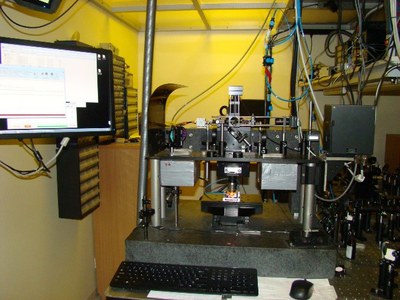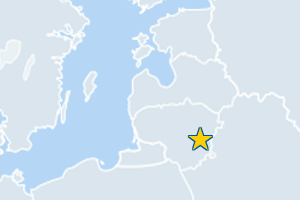VULRC (Vilnius, Lithuania)
Research highlights
Material Sciences (tissue engineering)
3D micro-structuring was performed at VULRC via two-photon polymerisation of poly (glycerol sebacate)-methacrylate - an elastomeric degradable polymer [Front. Phys. 6, 41 (2018)].
Nonlinear optics
Spectral broadening and conical emission of near-infrared femtosecond laser pulses in air was investigated [J. Phys. B: At. Mol. Opt. Phys. 51, 045402 (2018)].
Laser and optics technologies
VULRC allowed performing nano- and micromachining of a cell colonization membrane in photosensitive glass and fused silica by femtosecond laser technology for potential use in a Blood-Brain-Barrier-on-a-Chip.
Condensed matter physics
Coherent rare-earth pair excitation in Li6Y(BO3)3 crystals was investigated at VULRC.
Projects performed by external users >>
Further application highlights
3D Biomedical Imaging Lasers and Metrology
Expertise

Most of the research at VULRC is performed using femtosecond light pulses with some laser systems coupled to optical parametric amplifiers providing outstandingly broad (190 nm to 10 µm) tunability. Broadly tunable femtosecond pulses are used for spectroscopic applications and experiments on nonlinear optics from infrared to THz range. One such experimental setup is dedicated for investigation of filamentation and multioctave supercontinuum generation in bulk solids up to 5.5 mm. And even shorter (up to 15 fs) pulses tunable in the visible are also available and serves as a source for advanced holography/imaging setup.
Several Yb:KGW femtosecond amplifiers are used and one of them is unique model; which can produce 300 fs pulses at a continuously variable repetition rate in the range from 10 kHz to 400 kHz while maintaining unprecedented 20 W average power. The latter laser system is coupled to a cutting edge laser material processing workbench, where specimen areas of 150x150 mm can be processed with the transverse accuracy of 300 nm. The nanophotonics laboratory investigates light-mater interaction at direct laser writing 3D lithographic fabrication conditions and is also working on the development of multifunctional and integrated micro-optical and micro-fluidic components. Finally, a 1 kHz tabletop OPCPA system providing CEP-stable 10 fs pulses has recently became operational and is planned to be used for investigation of high-energy laser-matter interaction using real-time spectroscopic tools.
Equipment offered to external users
1. Femtosecond laser for industrial applications PHAROS-20W:
|
Wavelength |
1030 nm (fundamental) |
|
Pulse repetition rate |
1 – 600 kHz |
|
Average power |
20 W @200 kHz @1030 nm |
|
Pulse duration |
<300 fs, |
|
Pulse energy |
>0.4 mJ in range 1-5 kHz @1030 nm |
2. Tunable pulse repetition rate and wavelength femtosecond laser for fundamental light matter interaction studies, bio- and nanophotonics:
|
Wavelength |
300 – 2700 nm (continuously tunable) |
|
Pulse repetition rate |
1 – 1000 kHz of amplifier and 80 MHz of oscillator |
|
Average power |
6 W @200 kHz @1030 nm |
|
Pulse duration |
280 fs of amplified pulses and 80 fs of oscillator, |
|
Pulse energy |
>0.2 mJ in range 1-10 kHz @1030 nm |
3. Femtosecond laser 'Libra-USP-HE', TOPAS-800 parametric amplifiers and multi-pulse transient absorption setup, THz pulse generation:
|
Wavelength |
800 nm |
|
Pulse repetition rate |
1 kHz |
|
Average power |
3.5 W |
|
Pulse duration |
100 fs or 50 fs (user selectable, can be changed in range 0.05-10 ps) |
|
Pulse energy |
3.5 mJ |
|
Tuning range of TOPAS-800 parametric amplifiers |
240-12000 nm |
|
Output energy of TOPAS-800 |
50 uJ typical |
|
Pump wavelength range of multi-pulse transient absorption setup |
240-12000 nm, two independent simultaneously running pump beam lines |
|
Probe wavelength range of multi-pulse transient absorption setup |
240-12000 nm using TOPAS-800 (single point detectors) |
|
Delay range accessible in transient absorption experiments |
50 fs-8 ns |
|
Instrument response of multi-pulse transient absorption setup |
120 fs FWHM typical |
4. High average power sub 10 fs OPCPA system for experiments on HHG generation and light-matter interaction:
|
Wavelength |
800 nm |
|
Pulse repetition rate |
1 kHz |
|
Average power |
up to 10 W |
|
Pulse duration |
down to 8- 9 fs |
|
Pulse energy |
up to 10 mJ |
System equipped with vacuum chamber of HHG generation, and XUV spectrometer.
5. Femtosecond Ti:sapphire laser system coupled with tunable optical parametric amplifier for diverse experimental studies, THz pulse generation:
|
Main wavelength |
800 nm |
|
Wavelength from tunable OPA device |
250 – 9000 nm (continuously tunable) |
|
Pulse repetition rate |
1 kHz |
|
Average power |
10 W@800 nm |
|
Pulse duration |
35 fs |
|
Pulse energy |
Up to 10 mJ@800 nm and >50 mJ at any other wavelength within tuning range |
6. OPTICS CHARACTERIZATION (namely laser induced damage threshold testing) IS POSSIBLE AT SUCH IRRADIATION CONDITIONS INCLUDING VACUUM AND CRYO-COOLING
6.1 INNOLAS SpitLight Hybrid: Nd:YAG
|
Parameter |
Value |
|
Wavelength |
1064 nm (fundamental) |
|
532 nm (second harmonic) |
|
|
355 nm (third harmonic) |
|
|
266 nm (fourth harmonic) |
|
|
213 nm (fifth harmonic) |
|
|
Pulse repetition rate |
(1-100) Hz |
|
Average power |
30 W in range 50 Hz @ 1064 nm |
|
Pulse duration |
8 ns (FWHM) |
|
Pulse energy |
600 in range 50 Hz @ 1064 nm |
6.2 INNOLAS SpitLight DPSS: Nd:YAG
|
Parameter |
Value |
|
Wavelength |
1064 nm (fundamental) |
|
Pulse repetition rate |
1 kHz |
|
Average power |
10 W in range 1 kHz @ 1064 nm |
|
Pulse duration |
10 ns (FWHM) @ 1064 nm |
|
Pulse energy |
10 mJ in range 1 kHz @ 1064 nm |
Second (532 nm) and third (355 nm) harmonics are available with an external system (not part of the laser unit).
6.3 PHAROS-20W: Yb:KGW (with characteristics listed under 1. above)
6.4 COHERENT LIBRA: Ti:Sapphire
|
Parameter |
Value |
|
Wavelength |
800 nm |
|
Pulse repetition rate |
1 kHz |
|
Average power |
3.5 W in range 1 kHz @ 800 nm |
|
Pulse duration |
100 fs or 50 fs (user selectable, can be changed in range 0.05-10 ps) |
|
Pulse energy |
3.5 mJ in range 1 kHz @ 800 nm |
|
Tuning range of TOPAS-800 parametric amplifiers: |
240-12000 nm |
|
Output energy of TOPAS-800 |
50 µJ typical |
Second (400 nm) harmonics are available with an external system (not part of the laser unit).
6.5 EKSPLA NL303: Nd:YAG
|
Parameter |
Value |
|
Wavelength |
1064 nm (fundamental) |
|
532 nm (second harmonic) |
|
|
355 nm (third harmonic) |
|
|
266 nm (fourth harmonic) |
|
|
Pulse repetition rate |
10 Hz |
|
Average power |
30 W in range 50 Hz @ 1064 nm |
|
Pulse duration |
3 - 6 ns (FWHM) @ 1064 nm |


